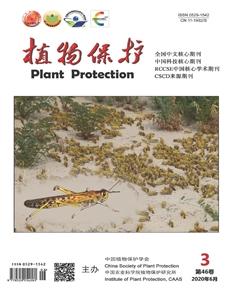新疆鹰嘴豆壳二孢疫病病菌Ascochyta rabiei交配型、致病力及其对3种杀菌剂的敏感性测定
蔡军 马德英 郁帆 羌松



摘要 新疆是我国鹰嘴豆主要生产地,然而随着鹰嘴豆种植面积的扩大,集约化种植模式的发展以及广泛从国内外引种,鹰嘴豆壳二孢疫病(Ascochyta blight)开始发生。由于该病害在新疆发生历史较短,相关的研究还甚少。本研究对新疆鹰嘴豆壳二孢疫病病菌Ascochyta rabiei的交配型、致病力及对3种杀菌剂敏感性进行测定,结果表明,A.rabiei的交配型MAT1-1和MAT1-2在新疆木垒地区的分离频率明显偏离1∶1,以MAT1-2为优势种群,但其致病力与MAT1-1无显著差异,而MAT1-1对30%醚菌酯EC的敏感性显著低于MAT1-2。
关键词 鹰嘴豆; 壳二孢疫病; Ascochyta rabiei; 交配型; 致病力; 杀菌剂敏感性
中图分类号: S 432.1
文献标识码: A
DOI: 10.16688/j.zwbh.2019086
Determination of mating type, virulence of Ascochyta rabiei
in Xinjiang and its sensitivity to three fungicides
CAI Jun, MA Deying, YU Fan, QIANG Song
(Key Laboratory of the Pest Monitoring and Safety Control on Crop and Forest at Universities of Xinjiang Uygur
Autonomous Region, College of Agronomy, Xinjiang Agricultural University, Urumqi 830052, China)
Abstract
Xinjiang is the main production area of chickpea in China. However, with the expansion of chickpea planting area, the development of intensive planting mode and the wide introduction of chickpea from home and abroad, Ascochyta blight occurred. Because of the short history of the disease in Xinjiang, little is known about this disease. In this study, the mating type and virulence of Ascochyta rabiei were characterized, and its sensitivity to three fungicides was also tested in Xinjiang. The results showed that the separation ratio of two mating types, MAT1-1 and MAT1-2, deviated from 1∶1 obviously in Mulei area of Xinjiang. The MAT1-2 was the dominant population, but its virulence showed no significant difference with that of MAT1-1. The sensitivity of the MAT1-1 mating type to kresoxim-methyl 30% EC was significantly lower than that of MAT1-2.
Key words
chickpea; Ascochyta blight; Ascochyta rabiei; mating type; virulence; fungicide sensitivity
鹰嘴豆Cicer arietinumL.是世界上种植面积居第2位的食用豆类,2017年世界总种植面积为1 456万hm2,总产量约达1 478万t[1]。壳二孢疫病(Ascochyta blight,病原菌为Ascochyta rabiei)是世界上危害鹰嘴豆最严重的病害[23]。该病原菌致病力变异是影响病害发生和流行的关键因素,而有性生殖是影响致病力变异的重要因素之一。真菌的有性生殖主要是由交配型基因控制[4]。A.rabiei是一种具有二极性交配系統的异宗结合子囊菌[57]。在世界上大多数鹰嘴豆种植地区,病原菌有性态(Didymella rabiei)在病残体上越冬,并在病害流行中起着重要作用。与大多数子囊菌一样,A.rabiei有性繁殖由具有两个等位基因的单个交配型基因位点(MAT)控制[8]。该位点基因控制雌雄配子配合和两性亲和细胞的激素调节,控制性别分化和有性发育,以及子囊孢子的大小等[4]。调控有性生殖的两种交配类型被称为MAT1-1和MAT1-2[57]。A.rabiei的有性繁殖取决于地理邻近的两种交配型的存在。地区间或地区内两种交配型的比例显著低于1∶1可能阻止有性阶段的形成,从而消除病原菌的重要来源并改变该病害的流行病学。缺乏有性阶段可能会对真菌在田间的传播、病害的流行病学或在鹰嘴豆作物间的长期存活产生重大影响[8]。
新疆是我国鹰嘴豆主要产地,然而随着鹰嘴豆种植面积的扩大和集约化种植模式的发展以及广泛从国内外引种,开始出现鹰嘴豆壳二孢疫病。鹰嘴豆壳二孢疫病于2008在我国新疆首次报道[9],之后相继报道了该病的防治措施、杀菌剂试验及抗性品种试验等。由于该病害在我国属于新入侵病害,因此相关研究工作非常少,主要以田间发病情况、造成的损失及防治措施为主,对于鹰嘴豆壳二孢疫病病原的生物学特性和基因组学研究较少。有性阶段的发展在病害流行病学和病原多样性中起着重要作用,增加病原菌群体之间的遗传变异性可能导致病原菌对杀真菌剂产生抗性和栽培种质丧失抗性。因此,确定鹰嘴豆种植地区病原菌的交配类型对于病害管理非常重要。虽然交配型测定已广泛用于确定病原菌群体样品中的交配型,但是相关研究多集中于交配型的频率,对于两种交配型的致病力差异等研究甚少。本试验通过对新疆鹰嘴豆主要种植区木垒县的病害调查,并采集病株样品进行室内分离纯化培养,完成交配型鉴定,对两种交配型的分离物进行致病力的室内人工接种鉴定以及对杀菌剂的敏感性测定,分析其在木垒的地理分布差异和两种交配型分离物的致病力及对杀菌剂的敏感性差异。
[3] KHAN M S A, RAMSEY M D, CORBIERE R, et al. Ascochyta blight of chickpea in Australia:Identification, pathogenicity and mating type [J]. Plant Pathology, 1999, 48:230234.
[4] 李國福. 新月弯孢菌(Curvularia lunate)交配型基因克隆分析及检测[D]. 沈阳: 沈阳农业大学, 2016.
[5] TRAPERO-CASAS A, KAISER W J. Development of Didymella rabiei, the teleomorph of Ascochyta rabiei, on chickpea straw [J]. Phytopathology, 1992, 82(11): 12611266.
[6] WILSON A D, KAISER W J. Cytology and genetics of sexual incompatibility in Didymella rabiei [J]. Mycology, 1995, 87: 795804.
[7] TURGEON B G, YODER O C. Proposed nomenclature for mating type genes of filamentous Ascomycetes [J]. Fungal Genetics and Biology, 2000, 31(1): 15.
[8] BARVE M P, ARIE T, SALIMATH S S, et al. Cloning and characterization of the mating type (MAT) locus from Ascochyta rabiei (teleomorph:Didymella rabiei) and a MAT phylogeny of legume-associated Ascochyta spp. [J]. Fungal Genetics and Biology, 2003, 39(2): 151167.
[9] 马德成, 魏建华, 曾繁明, 等. 新疆鹰嘴豆褐斑病的发生[J]. 植物检疫, 2008, 22(4): 245246.
[10]叶梅, 马德成, 魏建华, 等. 新疆鹰嘴豆褐斑病发生初报[J]. 新疆农业科技, 2008(2): 4344.
[11]马丽娟, 张巨松, 李利民, 等. 鹰嘴豆种质资源对Ascochyta rabiei的抗性评价及遗传多态性分析[J]. 植物遗传资源学报, 2013, 14(6): 11791184.
[12]PANDE S, SIDDIQUE K H M,KISHORE G K, et al. Ascochyta blight of chickpea (Cicer arietinum L.):A review of biology, pathogenicity, and disease management [J]. Australian Journal of Agricultural Research, 2005, 56(4): 317332.
[13]RHAIEM A, CHERIF M, DYER P S, et al. Distribution of mating types and genetic diversity of Ascochyta rabiei populations in Tunisia revealed by mating-type-specific PCR and random amplified polymorphic DNA markers [J]. Journal of Phytopathology, 2007, 155(10): 596605.
[14]KAISER W J. The teleomorph of Ascochyta rabiei and its significance in breeding chickpea [C]∥UDUPA S, WEIGAND F. DNA markers and breeding for resistance to Ascochyta blight in chickpea-Proceeding of the symposium on application of DNA fingerprinting for crop improvement: marker-assisted selection of chickpea for sustainable agriculture in the dry areas, ICARDA, Aleppo, Syria, 1997: 321.
[15]OMAR A, MICHAEL B, AHMED E A, et al. Chickpea Ascochyta blight: Disease status and pathogen mating type distribution in Syria [J]. Journal of Phytopathology, 2011, 159: 443449.
[16]AZIZPOUR N, ROUHRAZI K. Assessment of genetic diversity of Iranian Ascochyta rabiei isolates using rep-PCR markers [J]. Journal of Phytopathology, 2017, 165(7/8): 508514.
[17]ZHAN Jiasui, TORRIANI S F F, McDONALD B A. Significant difference in pathogenicity between MAT1-1 and MAT1-2 isolates in the wheat pathogen Mycosphaerella graminicola [J]. Fungal Genetics and Biology, 2007, 44(5): 339346.
[18]NAVAS-CORTS J A, PREZ-ARTS E, JIMNEZ-DIAZ R M, et al. Mating type, pathotype and RAPDs analysis in Didymella rabiei, the agent of Ascochyta blight of chickpea [J]. Phytoparasitica, 1998, 26(3): 199212.
[19]PHAN H T T, FORD R, BRETAG T, et al. A rapid and sensitive polymerase chain reaction (PCR) assay for detection of Ascochyta rabiei, the cause of Ascochyta blight of chickpea [J]. Australasian Plant Pathology, 2002, 31(1): 3139.
[20]PHAN H T T, FORD R, TAYLOR P W J. Mapping the mating type locus of Ascochyta rabiei the causal agent of Ascochyta blight of chickpea [J]. Molecular Plant Pathology,2003, 4(5): 373381.
[21]ARMSTRONG C L, CHONGO G, GOSSEN B D, et al. Mating type distribution and incidence of the teleomorph of Ascochyta rabiei (Didymella rabiei) in Canada [J]. Canadian Journal of Plant Pathology, 2001, 23(1): 110113.
[22]PEEVER T L, SALIMATH S S, SU G, et al. Historical and contemporary multilocus population structure of Ascochyta rabiei (teleomorph: Didymella rabiei) in the Pacific Northwest of the United States [J]. Molecular Ecology, 2004, 13(2): 291309.
[23]華乃震. 杀菌剂苯醚甲环唑的进展和应用[J].世界农药, 2013, 35(6): 712.
[24]赵平, 严秋旭, 李新, 等. 甲氧基丙烯酸酯类杀菌剂的开发及抗性发展现状[J].农药, 2011, 50(8): 547551.
(责任编辑:杨明丽)
收稿日期: 20190206 修订日期: 20190401
基金项目:国家自然科学基金(31560492)
致 谢: 参加本试验部分工作的还有江代礼、谭翰杰、张能和纪烨斌等同学,特此一并致谢。
通信作者E-mail:qse26@163.com
#为并列第一作者

